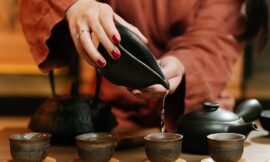7 ways tea is enjoyed around the world
Tea is a popular beverage enjoyed around the world, with a rich history and cultural significance. Here are some of the most popular methods of tea preparation and their origins:
1. Chinese Tea Ceremony:

The Chinese tea ceremony, also known as Gongfu Cha, is a traditional method of tea preparation that dates back to the Tang Dynasty (618-907 AD). It involves brewing tea in small clay teapots and serving it in small cups. The tea is brewed multiple times, with each infusion lasting only a few seconds. The ceremony emphasizes the importance of mindfulness, respect, and hospitality, and is often used for social and ceremonial occasions.
2. Japanese Tea Ceremony:

The Japanese tea ceremony, also known as Chanoyu or Sado, is a highly ritualized method of tea preparation that originated in Japan in the 16th century. It involves the preparation and serving of matcha, a powdered green tea, in a traditional tea room. The ceremony emphasizes harmony, respect, purity, and tranquility, and is often used for spiritual and cultural purposes.
3. Indian Chai:

Chai is a popular tea beverage in India, made by brewing black tea with a blend of spices, such as cardamom, cinnamon, ginger, and cloves. The tea is typically brewed with milk and sugar, resulting in a creamy, sweet, and spicy beverage. Chai is often served in small glasses and is a staple of Indian culture, consumed throughout the day and offered to guests as a sign of hospitality.
4. British Afternoon Tea:

Afternoon tea is a British tradition that dates back to the 19th century. It involves the serving of tea, sandwiches, scones, and pastries in the mid-afternoon, typically between 3-5 pm. Afternoon tea is often associated with elegance, refinement, and socializing, and is a popular activity for special occasions and gatherings.
5. Moroccan Mint Tea:

Moroccan mint tea is a traditional tea preparation method in Morocco, made by brewing green tea with fresh mint leaves and sugar. The tea is typically served in small glasses and is a symbol of hospitality and friendship. Moroccan mint tea is often consumed throughout the day and is an integral part of Moroccan culture.
6. Russian Samovar Tea:

The samovar is a traditional Russian tea urn that is used to brew and serve tea. The samovar is typically filled with hot water, and loose tea leaves are placed in a small teapot on top of the urn. The tea is brewed strong and is often served with lemon, sugar, and jam. The samovar is a symbol of Russian hospitality and is often used for social and ceremonial occasions.
7. Turkish Tea:

Turkish tea, also known as çay, is a popular tea beverage in Turkey, made by brewing black tea in a special double teapot called a çaydanlık. The tea is typically served in small glasses and is often consumed throughout the day, with meals, and during social gatherings. Turkish tea is a symbol of hospitality and is an integral part of Turkish culture.
These are just a few examples of the many tea preparation methods around the world, each with its own unique history, cultural significance, and characteristics. Tea is a versatile beverage that can be enjoyed in many different ways, reflecting the diversity of human culture and tradition.





